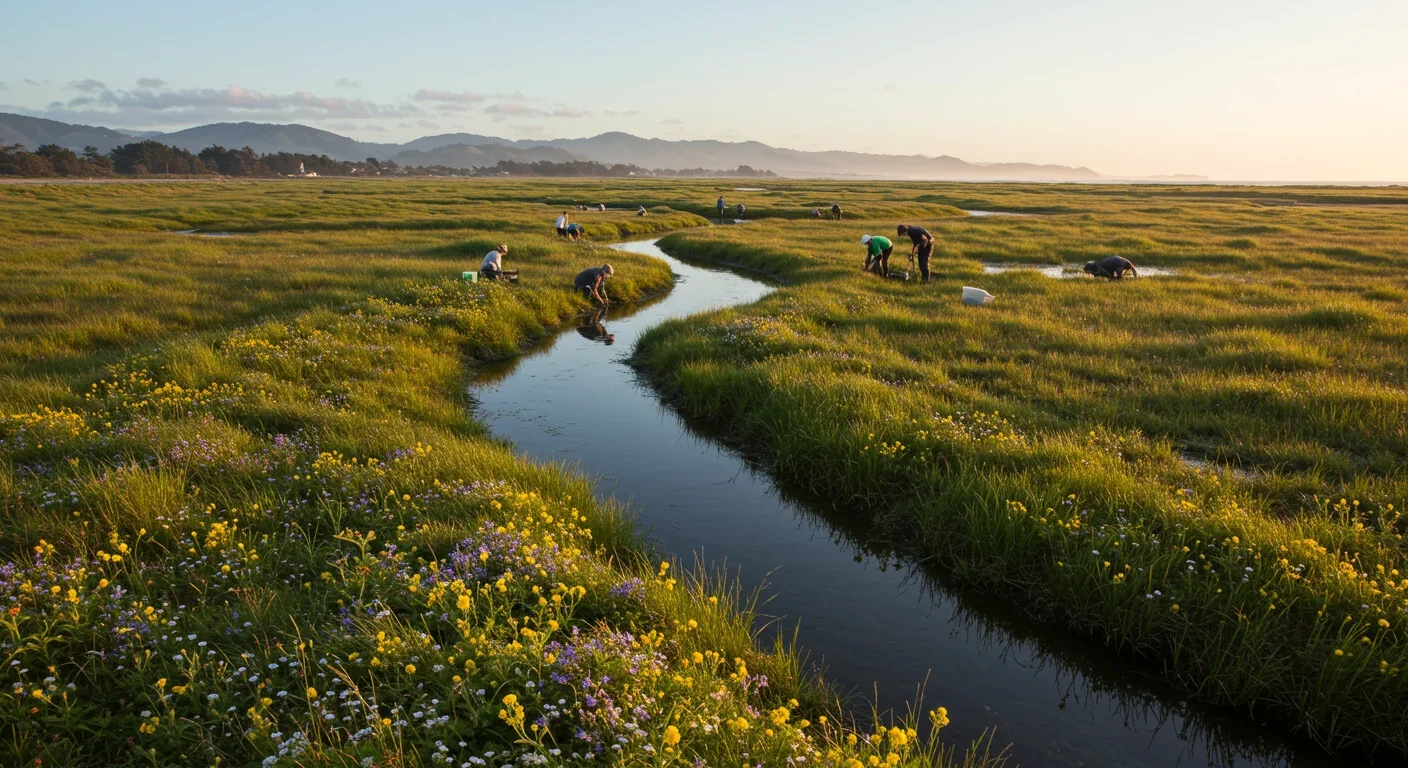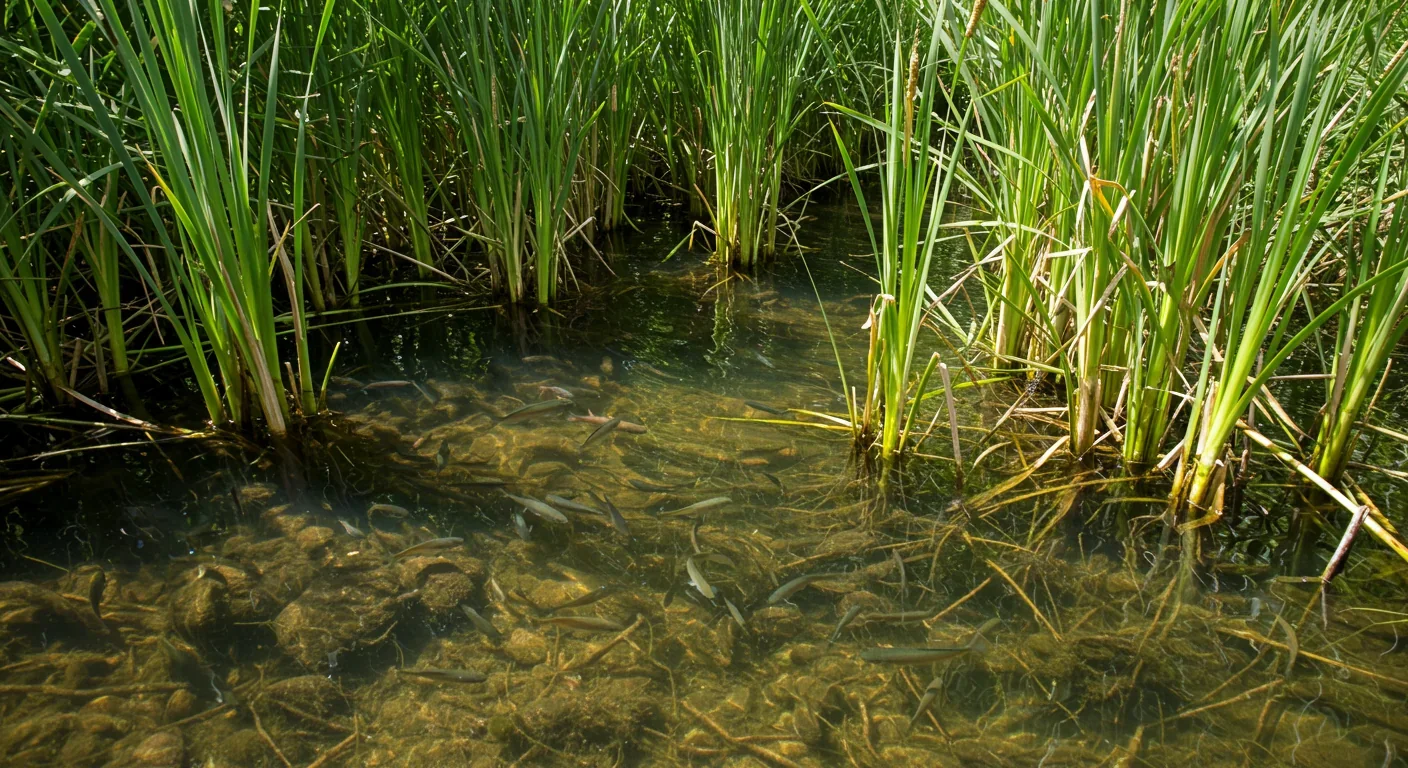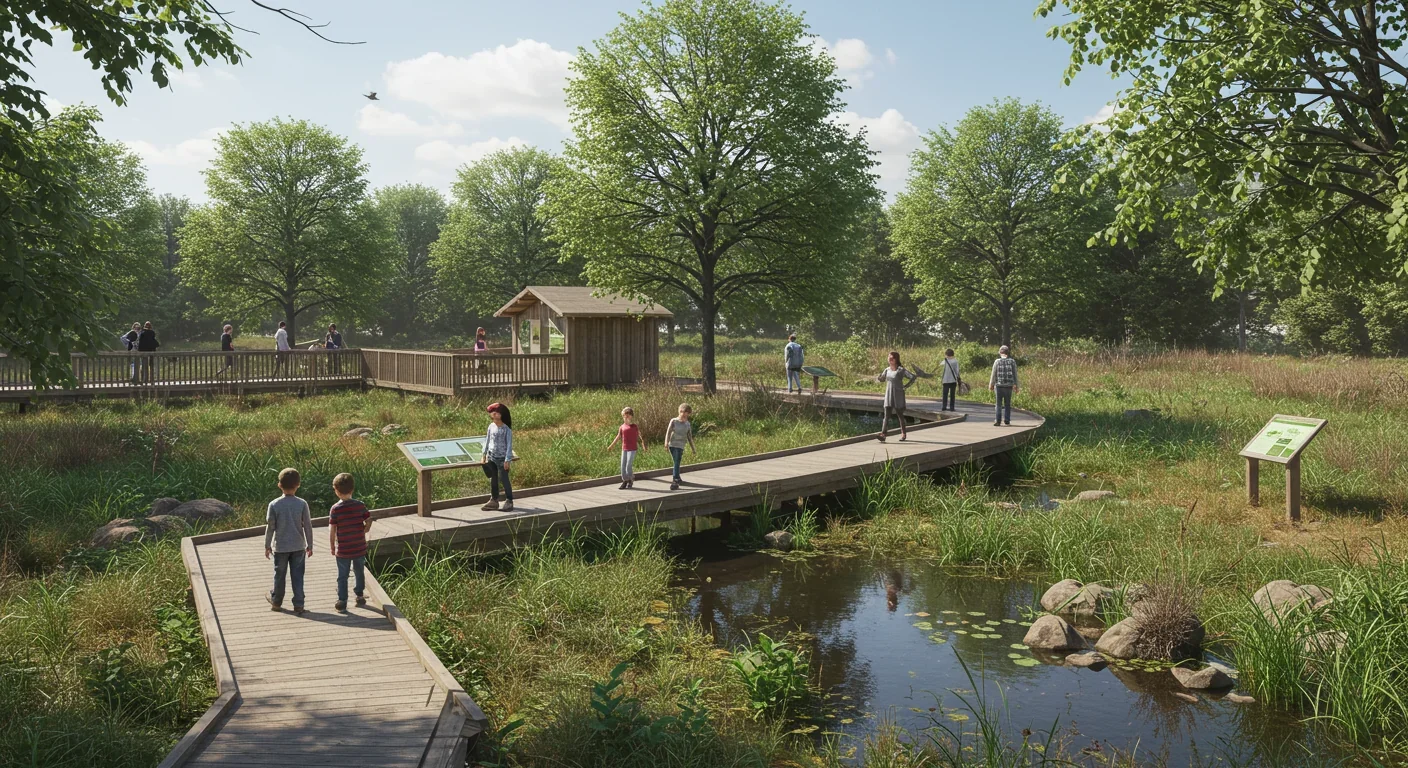Digital Pollution Tax: Can It Save Data Centers?

TL;DR: Wetlands filter pollutants through sediment trapping, microbial breakdown, and plant uptake, rivaling mechanical treatment systems at a fraction of the cost while providing flood protection, carbon storage, and biodiversity benefits.

By 2035, over 4 billion people will face severe water scarcity unless we revolutionize how we clean our water. But the solution isn't another mega-infrastructure project, it's something we've been destroying for centuries: wetlands. These soggy, unassuming landscapes filter pollutants better than any technology we've built, and restoration projects worldwide are proving that nature's engineering beats ours, hands down.
Here's what researchers have discovered that changes everything: wetlands don't just hold water, they actively transform it. Through a combination of sediment trapping, microbial breakdown, and plant uptake, these ecosystems remove nitrogen, phosphorus, heavy metals, and even pharmaceutical residues from water flowing through them. Think of them as living water treatment plants that run on sunlight instead of electricity.
The science is surprisingly elegant. When water slows as it enters a wetland, suspended particles settle out. Meanwhile, dense microbial communities in the soil go to work, converting harmful nitrates into harmless nitrogen gas through a process called denitrification. Plants like cattails and bulrushes absorb excess nutrients and trap heavy metals in their root systems. The result? Water emerges cleaner than it entered.
Recent studies show that constructed wetlands can remove up to 90% of suspended solids, 80% of nitrogen compounds, and significant amounts of pathogens. That performance rivals advanced mechanical treatment systems, but at a fraction of the cost and with zero energy inputs.
We didn't always understand what we were destroying. Since 1900, the world has lost over 64% of its wetlands, drained for agriculture, paved over for development, or filled in because they seemed like wasted space. The United States alone has lost 53% of its original wetlands since European colonization.
This wasn't just an environmental loss, it was an infrastructure catastrophe we're only now beginning to comprehend. Every acre of wetland we eliminated was one less buffer against floods, one less carbon sink, one less water purification system. The Chesapeake Bay, once fringed with vast wetlands, became one of America's most polluted estuaries as farmland runoff overwhelmed its remaining natural filters.
The Mississippi River Delta tells a similar story. Decades of levee construction and wetland drainage left New Orleans vulnerable to catastrophic flooding. When Hurricane Katrina struck in 2005, the lack of coastal wetlands to absorb storm surge contributed to the disaster's severity. We built walls to control water while destroying the ecosystems that had protected us for millennia.
Understanding wetland filtration means appreciating the complexity hidden in what looks like muddy ground. The process operates on multiple levels simultaneously.
Sediment Trapping: As water velocity decreases entering a wetland, gravity does its work. Suspended particles, heavy metals attached to sediment, and phosphorus bound to soil all settle out. Studies show that wetland vegetation can reduce flow velocity by 90%, dramatically increasing particle capture.
Microbial Breakdown: The real magic happens underground. Wetland soils host some of the most diverse microbial communities on Earth. These microorganisms transform pollutants through chemical reactions. Aerobic bacteria near the surface break down organic compounds, while anaerobic bacteria deeper in the soil convert nitrates to nitrogen gas, removing reactive nitrogen from the water cycle entirely.
Plant Uptake: Wetland plants aren't passive bystanders. Their extensive root systems create pathways for oxygen to reach deeper soil layers while absorbing nutrients like phosphorus and nitrogen. Some species, called hyperaccumulators, can extract heavy metals from contaminated water and sequester them in their tissues.
The system is self-regulating and self-maintaining. Unlike mechanical treatment plants that require constant energy inputs and chemical additions, wetlands run on solar power and get more efficient over time as microbial communities mature and vegetation establishes.

The Chesapeake Bay Program represents one of the world's largest wetland restoration efforts. Since 1983, over 8,000 acres of wetlands have been restored around the bay, removing an estimated 1.5 million pounds of nitrogen and 100,000 pounds of phosphorus annually. The project combines federal funding, state initiatives, and community engagement to bring back tidal marshes and forested wetlands.
Results have been measurable. Water clarity has improved in restoration zones, fish populations have rebounded, and flooding has decreased in adjacent communities. The program demonstrates that large-scale ecological restoration can deliver tangible benefits, though challenges remain in sustaining funding and political will.
In New Zealand, the Waikato River wetland restoration showcases partnership-driven success. By working with indigenous Māori communities and local farmers, the project restored 500 hectares of wetlands along the country's longest river. Water quality monitoring shows nitrogen levels dropping by 30% in restored sections, while native bird populations have surged.
Singapore takes a different approach with urban wetlands. The ABC Waters Programme integrates constructed wetlands into city infrastructure, treating stormwater runoff while creating recreational spaces. These projects prove wetlands can thrive even in dense urban environments, filtering pollution from streets and rooftops before it reaches waterways.
The Mississippi River Basin initiatives focus on reconnecting the river to its floodplain. By removing levees in strategic locations and restoring wetlands, these projects reduce downstream flood risk while improving water quality. Natural infrastructure performs functions that would cost billions if built with concrete and steel.
In Africa, the Bangweulu Wetlands conservation project in Zambia protects one of the continent's largest wetland systems while improving water quality for downstream communities. The project demonstrates how biodiversity conservation and water security goals align when wetlands are properly managed.
Traditional water treatment infrastructure is expensive. Building a conventional treatment plant costs millions, with ongoing operational expenses for energy, chemicals, and maintenance. A recent analysis found that natural infrastructure like wetlands costs 50-80% less than gray infrastructure while providing equivalent or superior water quality improvements.
Wetlands deliver multiple benefits that gray infrastructure cannot. They provide flood protection, storing water during storms and releasing it slowly. They sequester carbon, with coastal wetlands storing carbon at rates up to 40 times faster than tropical forests. They support biodiversity, providing habitat for fish, birds, and countless other species. And they create recreational opportunities that enhance community well-being and property values.
The return on investment is compelling. Every dollar spent on wetland restoration in the Chesapeake Bay generates an estimated $7.50 in ecosystem service benefits. Flood mitigation alone can justify restoration costs, as demonstrated in the Prairie Creek Watershed, where restored wetlands prevented an estimated $12 million in flood damage during recent extreme weather events.
Multiple funding mechanisms now support wetland restoration. Federal programs like the U.S. Environmental Protection Agency's wetland grants provide baseline support. The 2021 Infrastructure Investment and Jobs Act allocated $1 billion for wetland restoration and conservation.
Biodiversity-positive tradable permits represent an innovative financing approach. These market-based instruments allow developers to offset habitat impacts by funding restoration elsewhere, creating revenue streams for wetland projects. Australia's environmental offset schemes have generated over $200 million for restoration.
Carbon markets offer another pathway. As wetlands' carbon sequestration value gains recognition, carbon credits could fund restoration at scale. California's cap-and-trade program already accepts wetland restoration projects for carbon offset credits.
Community engagement strategies have proven essential for long-term success. The North Carolina Watershed Management program demonstrates how involving local stakeholders from project inception builds support and ensures maintenance. When communities understand wetlands as assets rather than obstacles, restoration becomes sustainable.

For decades, wetland science lagged behind other environmental fields. We knew wetlands were important but couldn't quantify their benefits precisely enough to justify restoration investments. That's changing.
Advanced monitoring technologies now measure wetland performance in real-time. Sensors track water quality inputs and outputs, documenting pollutant removal rates. Satellite imagery assesses vegetation health and extent. Genetic sequencing reveals microbial community composition and function.
Research on microbial communities has been particularly enlightening. Scientists now understand how different bacterial species contribute to nitrogen removal, how flow conditions affect microbial performance, and how to optimize wetland design for maximum pollutant degradation. This knowledge enables more effective restoration.
Studies on constructed wetland substrates have identified materials that enhance filtration. Adding biochar or iron-rich media can boost phosphorus removal. Specific plant combinations maximize nutrient uptake. These refinements make modern restored wetlands more efficient than their natural predecessors.
Long-term monitoring reveals wetland resilience. Marsh terracing studies in Louisiana show restored wetlands maintaining function through hurricanes and droughts. This durability makes wetlands reliable infrastructure components, not just ecological experiments.
Individual action matters more than you might think. Start by learning about wetlands in your watershed. Most regions have lost significant wetland area, and local restoration opportunities likely exist near you.
Volunteer with restoration organizations like the Land Restoration and Wetland Protection groups active in most states. These groups organize planting days, monitoring activities, and educational events. Physical participation helps, but so does lending professional expertise, whether that's project management, fundraising, or communications.
Advocate for policy changes at the local level. Attend city council or county commission meetings to support wetland protection ordinances. Many communities lack adequate wetland regulations, allowing development to destroy these ecosystems. Your voice can shift political calculus.
Support organizations doing the work. Wetlands International and local land trusts operate restoration projects worldwide. Financial contributions, no matter how small, fund the unglamorous but essential work of land acquisition, permits, and monitoring.
Change your own property if possible. Homeowners can create small wetlands or rain gardens that filter runoff before it reaches storm drains. These micro-wetlands won't solve watershed-scale problems alone, but thousands of them collectively make a difference. Extension services offer design guidance.
Stay informed and share knowledge. The science of wetlands evolves rapidly, with new findings published regularly. Understanding these ecosystems helps you make the case to skeptical neighbors, elected officials, or family members.
We're at a decision point. Climate change is intensifying floods and droughts while agricultural and urban pollution overwhelms water systems. We can respond by building more dams, treatment plants, and levees, pouring billions into infrastructure that fights nature. Or we can work with nature by restoring the wetlands that filtered our water, protected our coasts, and supported biodiversity for millions of years before we arrived.
The restoration projects already underway prove the concept works. From the Chesapeake Bay to Singapore's urban wetlands, wetlands are cleaning water, reducing floods, and sequestering carbon. The science is settled. The economics favor restoration. The technology exists.
What's missing is collective will. Wetlands lack the visual drama of forests or coral reefs. They're muddy, buggy, and hard to love at first glance. But they're among the most productive ecosystems on Earth, and we need them more than ever.
The next decade will determine whether we continue draining and degrading wetlands or reverse course. Every acre restored is a water treatment plant that will run for centuries. Every community that protects its wetlands invests in resilience against the climate impacts already unfolding.
The ultimate water purifier isn't technology we'll invent tomorrow. It's the wetlands we've spent generations destroying. The question is whether we're smart enough to bring them back before it's too late. The water we drink and the communities we build depend on getting this right.

Recent breakthroughs in fusion technology—including 351,000-gauss magnetic fields, AI-driven plasma diagnostics, and net energy gain at the National Ignition Facility—are transforming fusion propulsion from science fiction to engineering frontier. Scientists now have a realistic pathway to accelerate spacecraft to 10% of light speed, enabling a 43-year journey to Alpha Centauri. While challenges remain in miniaturization, neutron management, and sustained operation, the physics barriers have ...

Epigenetic clocks measure DNA methylation patterns to calculate biological age, which predicts disease risk up to 30 years before symptoms appear. Landmark studies show that accelerated epigenetic aging forecasts cardiovascular disease, diabetes, and neurodegeneration with remarkable accuracy. Lifestyle interventions—Mediterranean diet, structured exercise, quality sleep, stress management—can measurably reverse biological aging, reducing epigenetic age by 1-2 years within months. Commercial ...

Data centers consumed 415 terawatt-hours of electricity in 2024 and will nearly double that by 2030, driven by AI's insatiable energy appetite. Despite tech giants' renewable pledges, actual emissions are up to 662% higher than reported due to accounting loopholes. A digital pollution tax—similar to Europe's carbon border tariff—could finally force the industry to invest in efficiency technologies like liquid cooling, waste heat recovery, and time-matched renewable power, transforming volunta...

Humans are hardwired to see invisible agents—gods, ghosts, conspiracies—thanks to the Hyperactive Agency Detection Device (HADD), an evolutionary survival mechanism that favored false alarms over fatal misses. This cognitive bias, rooted in brain regions like the temporoparietal junction and medial prefrontal cortex, generates religious beliefs, animistic worldviews, and conspiracy theories across all cultures. Understanding HADD doesn't eliminate belief, but it helps us recognize when our pa...

The bombardier beetle has perfected a chemical defense system that human engineers are still trying to replicate: a two-chamber micro-combustion engine that mixes hydroquinone and hydrogen peroxide to create explosive 100°C sprays at up to 500 pulses per second, aimed with 270-degree precision. This tiny insect's biochemical marvel is inspiring revolutionary technologies in aerospace propulsion, pharmaceutical delivery, and fire suppression. By 2030, beetle-inspired systems could position sat...

The U.S. faces a catastrophic care worker shortage driven by poverty-level wages, overwhelming burnout, and systemic undervaluation. With 99% of nursing homes hiring and 9.7 million openings projected by 2034, the crisis threatens patient safety, family stability, and economic productivity. Evidence-based solutions—wage reforms, streamlined training, technology integration, and policy enforcement—exist and work, but require sustained political will and cultural recognition that caregiving is ...

Every major AI model was trained on copyrighted text scraped without permission, triggering billion-dollar lawsuits and forcing a reckoning between innovation and creator rights. The future depends on finding balance between transformative AI development and fair compensation for the people whose work fuels it.